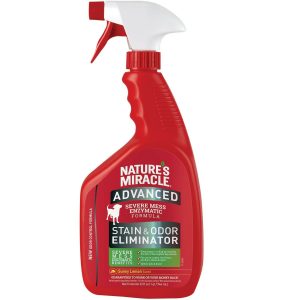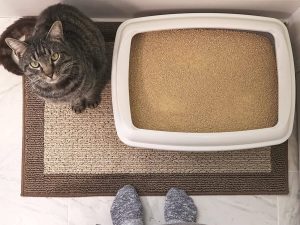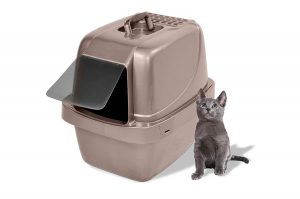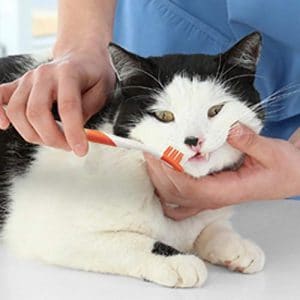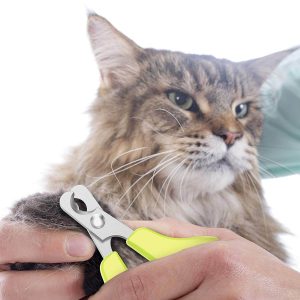Pet Care » How to Stop your Cat from Biting
How to Stop Your Cat From Biting (And What to Do If They Won’t)
Author:
Popular Articles:

And the truth is that this behavior can often be stopped if you’re able to get to the root of the problem. Read on, and we’ll explore some ways to get your feline friend to quit chomping on folks and how to make things safer for those around cats that simply won’t quit attacking people.
So, Why Do Cats Bite?
Most actual wounds that occur come from feral cats. In those cases, the animal is most likely acting defensively. You may see a cute kitty, but it sees a threat, which is multiple times its size. Always be wary approaching ferals, cats may be small, but they’re fast. A cat that actually attacks is a handful, especially if you’re trying not to hurt the animal.
On the other hand, pet cats do bite on occasion.
“Love bites” are behavior that occurs on occasion when a cat is particularly happy. They generally nibble a bit and don’t pierce the skin when doing so. It’s a compliment, a bit of nostalgia for their kitten days when their mother would do the same while grooming them.
There’s even a veterinary term for it: “Petting-induced Aggression.”
You’ll notice when it occurs that there aren’t any other signs of aggression. Before a cat actually bites someone, they will typically hiss, arch their back, growl, and let the person know that a fight is about to go down.

You’ll need to know the difference before we proceed. If your cat is nibbling on you affectionately, it’s still a behavior that many people want to correct, and it’s certainly possible.
Stopping Love Bites From Your Cat
Love bites are a pretty frequent behavior in cats. As long as they don’t break the skin, it’s usually more irritating than actually dangerous, but trying to stop them can be frustrating for owners who don’t understand their feline friend’s psychology.

The important thing is to not react with an overly negative correction. Some people will grab their cat by the scruff, spraying the cat, or otherwise acting in an “aggressive” manner.
That’s not the right way to go about things. Some cats will then escalate their behavior to true aggression, putting you at risk of getting bit or scratched while they react to the perceived threat.
Instead, back off immediately from where you’re petting the cat. They’ll start to get the picture after a couple of times.
You should also keep the following in mind:
- Avoid trying to pet your cat when they get the zoomies. During these bouts of excited behavior, the cat is much more likely to bite than you’d otherwise think.
- Always invite your cat over to be petted. If you pet a cat that is resting or sleeping, they’ll be more likely to respond without thinking.
- Try petting areas which the cat enjoys but don’t lead to overstimulation. The belly and the base of the tail are quite sensitive and a good way to get clawed or bitten when the cat is enjoying the grooming. The head and ears are a much safer bet.

There are also minor signs that most people won’t catch like dilated pupils.
Understanding your cat’s body language is the key to avoid getting bitten, of course, but stopping the behavior entirely makes more concentrated work.
The easiest place to begin is with cats that lick before they chew. In these cases, you’ll want to stop petting entirely when they lick. While some people enjoy that scratchy tongue, it’s not really a good idea to let your cat begin to chew on you.

It’s a concentrated effort here: you need to quit your behavior, which overstimulates the cat and discourages them from chewing on you.
Keep in mind this only applies to love bites; for more aggressive cats, different measures will have to be taken.
Stopping an Aggressive Cat From Biting
Sometimes rescue cats and ferals that people have taken in are extremely aggressive.

Body language is key to understanding here. At least if the cat is tame enough, you can get near it. Pupil dilation, flattening of the ears, and an arched back are all signs that a cat is ready to attack. Keep an eye out for these signs throughout the taming process.
The most important thing to do is to get the cat to associate people with good times. All of the following are good ways of getting an overly aggressive cat to calm down.
- Spend at least twenty minutes in the room with the cat twice a day. Feed them treats even if they decide to hide from you. You can leave the room with some treats still on the floor if the cat refuses to come out.
- Once the cat is ready to come out, try using a small fishing pole with a toy tied to the end to play with it. This helps the cat associate humans with playtime instead of just previous abuse or unfamiliarity.
- Once the cat has calmed down enough to be around you, you can try petting it. Always leave an escape route for the cat and don’t force it, but once you’ve got a couple of head scritches in, give it some treats.
- Feed the cat smaller bowls 3-4 times a day rather than just filling their bowl.
These can help get even the worst cat to a manageable level of aggression. Food and play are the common factors here, but cats that have been heavily abused and neglected, or feral adults, may never be the lovey pet that most people want.
Still, in some cases, more extreme measures are needed. Whether it’s a feral mother who’s kittens, need treatment or an aggressive cat that may seek to actively attack the vet during a procedure, these rare instances call for more extreme measures.
Cats that are injured can often become quite aggressive. In these instances, you may also want to take a look at the next section.
If your cat has behavioral problems, then check out Starting from Scratch: How to Correct Behavior Problems in Your Adult Cat, which is our favorite book on the subject. After all, biters often have other problems to go along with them.
Using a Cat Muzzle
Extreme cases call for extreme measures. Muzzles aren’t just for aggressive dogs, there are also feline models available.

Others use them to get their cat calmed down for nail trimming and other small procedures that can be done at home. Most cats will find a muzzle to be calming in the end, but getting them on can mean risking getting scratched.
The truth is that the best cat muzzle is the one on hand. Most cat owners will find them useful at some point, and they’re quite cheap, so picking one up is a good idea. Leave it in a pet first aid kit, and you’re on the right track.
The ideal feline muzzle will have the following qualities:
- Cover the Eyes: Covering the eyes, as well as the mouth, of the cat, is the biggest difference for a cat muzzle and a canine one. Covering the eyes will calm the cat once it’s been placed.
- Tough Material: The material used should be tough enough to withstand the cat’s claws as well as their teeth. Most cats will try to remove a muzzle or prevent it from being placed.
- Breathable: Your cat still needs to breathe when muzzled without the hole being large enough to allow for bites.
As long as all of those are in place, you’ll be in good hands.
The Best Cat Muzzle
Personally, we recommend the Downtown Pet Supply Cat Muzzle. It’s cheap, easy to use, and can be sized for any cat. The truth is most are the same overall, it’s a pretty simple design.
Cat Bites Are Much More Dangerous Than Cute
Cat bites aren’t just painful, they can actually be dangerous to both humans and other animals.
Unlike the relatively clean mouths of canines, felines tend to carry a heavy amount of bacteria in their mouths. In addition, their teeth are both long and thin, which is a dangerous combination. While the wounds themselves are relatively minor, these puncture wounds often close quickly.
And that can trap the pathogens inside your body.
Their claws can do the same, but the jagged edges and longer wounds tend to be more open and not as prone to causing infections. This is doubly true if you treat them soon after the injury occurs.
Since bites can become infected so easily, it’s important to take proper first aid measures immediately after being bitten. The same procedure should also be done for any scratches which break through the first layer of the skin.
If wounded by a cat, do the following:
- Rinse the wound with running water and soap as soon as possible.
- Do not use disinfectants like isopropanol for a bite, while fine for surface damage, a cat’s bite leaves deeper puncture wounds, and it will do more harm than good.
- Use saltwater to rinse the wound.
- Control bleeding by applying pressure.
- When bleeding is controlled, wash the surface of the skin again and bandage the wound. Change the dressing daily.
- If redness, swelling, or pustules occur, then get to the local Emergency Room as soon as possible.
It only takes a day or two for an infection from a cat bite to get out of hand. It’s important to get it handled. Hopefully, your cat has had their shots(and you have the documentation) in the event you need to visit a doctor, as the feline will need to be placed in quarantine for 10-14 days otherwise.
Cats are loveable little critters, but things can get dangerous if they draw blood.
But “cat scratch fever” is more than a song by Foreigner and it can cause permanent damage or even death in extreme cases. Take care of your bite wounds.
Make Biting a Thing of the Past
When our cats bite, it can hurt on more than one level. With a bit of insight and the right tools, however, you can make biting a thing of the past. Our cats don’t want to hurt us, but sometimes behavior problems crop up, and it can be hard to correct them.
So, make sure you have a muzzle in your cat’s kit and start to modify their behavior carefully. It’s time to make feline gnawing, slashing, and chewing a thing of the past.
Last Updated:
Author:
Popular Articles:




